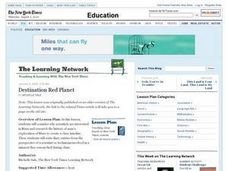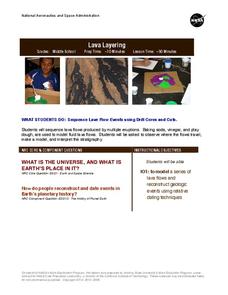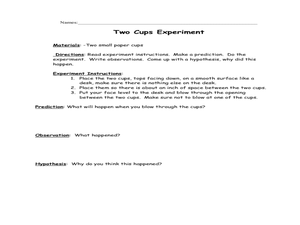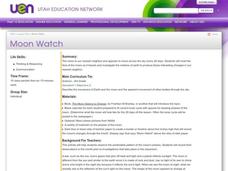Curated OER
Space Exploration
Sixth graders identify and interpret the following: What is space?, Space Race, Living in space?, Man on the Moon, Astronaut training; students compare/contrast US and Russia space exploration. Students write a letter of application to...
Curated OER
Get a Leg Up
Traveling through space is an amazing experience, but it definitely takes a toll on the body. After reading an article and watching a brief video, learners perform an experiment that simulates the effects of zero gravity on the...
Curated OER
Communication Delay
Construct a maze in your classroom and have a blindfolded scientist act as a space rover, maneuvering unfamiliar terrain while another scientist plays commander. Classmates record the number of occurrences of the commander having to...
Curated OER
Space Exploration to Find Habitable Planets
Students explore space science by reviewing scientific vocabulary terms. In this planet identification lesson, students identify the nine planets in our solar system and discuss which ones could potentially harbor life at some point....
Curated OER
The Space Cadet's Laboratory: Using Electromagnetic Energy to Study Astronomy
Young scholars build their own spectrophotometer to study light. In this physics lesson, students explain the dual nature of light. They calculate the angle of incidence and refraction using Snell's law equation.
Curated OER
Destination Red Planet
Young scholars explore reasons why people are interested in exploring other planets. After reading an article, they identify developments in the mission to Mars. Using the internet, they research the history of exploring Mars and...
Curated OER
Distance in Space
Sixth graders explore space science by measuring distances between planets. In this solar system lesson, 6th graders view a Bill Nye video and discover the conversion between the metric system and imperial measuring systems. Students...
Curated OER
Science That's Out of This World
Students use iChat AV and an iSight camera to "meet with" a space scientist to ask and answer questions, visit relevant websites, and broaden their understanding of the solar system and space. They videoconference with a sientist and...
Curated OER
Discoveries of Titanic Proportions
Students analyze various statements on the moon. After reading an article, they discuss the findings about a new moon around Saturn. In groups, they re-create a press conference in which the new findings were released to the public. ...
Curated OER
Introduction to Photovoltaic Systems
The Green Education Foundation found that this lesson plan, written by the Texas State Energy Conservation Office, is right up their alley when it comes to teaching sustainability. It is ideal as a first lesson plan on photovoltaic...
Curated OER
Space Trader And Economics
Students' play a game applying different economic and game terms. In the game, the students' are to travel to 4 planets which provide the best resources for increasing their money to purchase a moon in the end. The students' keep track...
Curated OER
The Lighter Side of Color
Students explore light and color, including how colors are mixed to produce new colors, how light is filtered, and how light is reflected off of surfaces. They read materials provided, complete worksheets, and complete hands-on activities.
Curated OER
Observing the Outer Planets
Students observe the outer planets. In this science lesson, students use a telescope locate the outer planets of the solar system. Students create a video of their observations.
NASA
Lava Layering
Take the old baking soda and vinegar volcano to the next level by using it to study repeated lava flows over time, examine geologic features on Earth and Mars, and speculate about some of the formations on Mars.
Curated OER
Understanding Bernoulli's Principle
Fifth graders explain why we fly. For this space science lesson, 5th graders discuss Bernoulli's prinicple and its relation to flight.
Curated OER
Special Delivery
Students are given an envelope with the name of a locomotor skill. As a class, they practice reading the name of the skill and practice doing the movement. To end the lesson, they complete the movement only when the music is playing.
Curated OER
Character Traits in Gingerbread Baby #5
Students are read the story "Gingerbread Baby". They draw or download the characters and cut them out. They create character profiles for each character based on how they acted in the book. They act out a scene from the story as well.
Curated OER
Exploring the Interstellar Medium
Students investigate the Interstellar Medium and the Local Bubble that the Sun is inside. They read and discuss a handout, answer discussion questions, observe a demonstration of light scattering, and conduct an experiment on the...
Curated OER
Launching Rockets
Second graders discuss experiences of watching a rocket launch either on television or in person before making paper rockets. They make and color rockets which they attempt to launch using a strong breath blown through a straw at the...
Curated OER
Nature of Meteor Showers
Ninth graders describe, in general terms, the distribution of matter in space and
identify evidence for, and describe characteristics of, bodies that make up the solar system. They then investigate predictions about the motion,...
Curated OER
Moon Watch
Third graders read books about the moon and discuss its perceived changes as it moves across the sky. They observe the moon over the course of a month and chart their observations. They discuss their observations and conduct further...
Curated OER
Project X-35
Students demonstrate rocketry principles through a cooperative, problem solving simulation. They work in teams to simulate the development of a commercial proposal to design, build, and launch a rocket.
Curated OER
Why Do We Have Night?
Learners engage in a fun, creative way to discover how the Earth moves. This lesson helps students explain why there is day and night. It can also create curiosity to further study the solar system and eclipses!
Curated OER
Boxes & Blocks: Puffer Bellies and Box Cars
Students turn cardboard boxes into outdoor dramatic play. In this early childhood visual arts lesson, students explore cooperative and dramatic play outdoors by challenging children to create a train from cardboard boxes.























